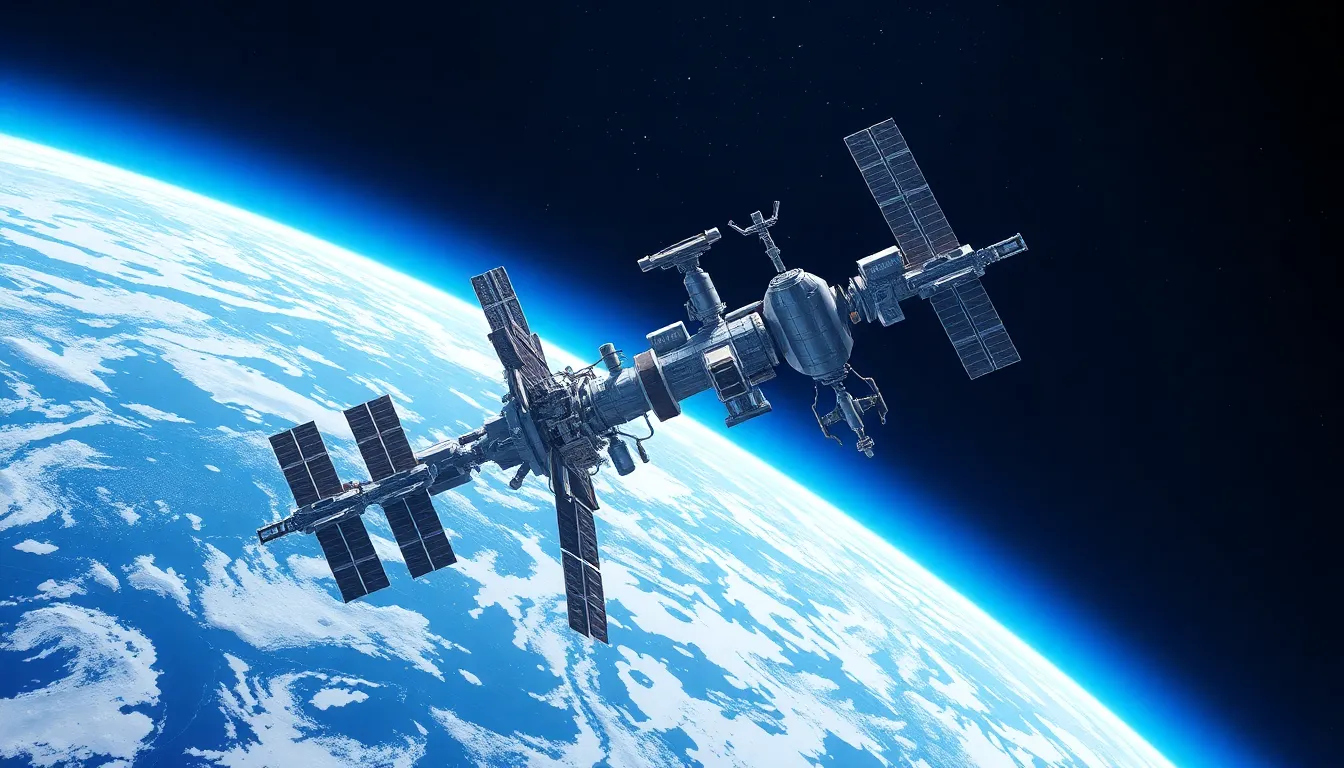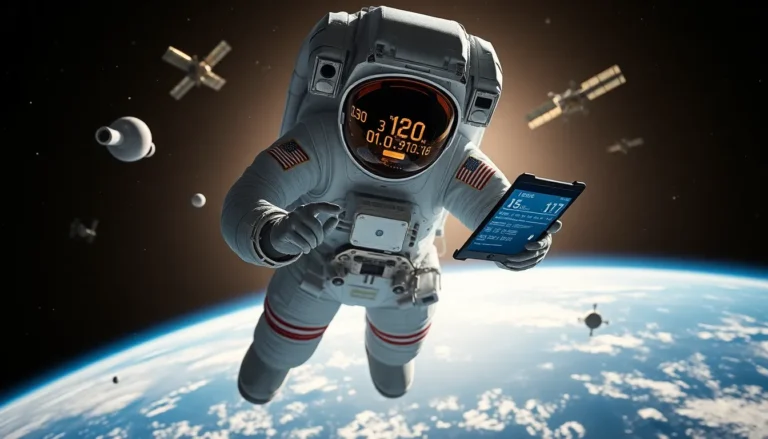Floating high above Earth, space stations are like the ultimate treehouses for astronauts. Imagine a place where gravity takes a vacation and science experiments soar to new heights—literally! These remarkable structures serve as laboratories, observatories, and even homes for those brave enough to venture into the cosmos.
Table of Contents
ToggleOverview of Space Stations
Space stations serve as unique laboratories orbiting Earth, providing environments for groundbreaking research and human habitation. These structures host various scientific activities, allowing astronauts to conduct experiments that benefit life on Earth and expand knowledge of the universe.
Definition and Purpose
Space stations are habitable artificial satellites that orbit Earth. They function primarily as research facilities, enabling scientists to study effects of microgravity on biological organisms and physical processes. Auxiliaries include serving as a base for technology demonstrations and international collaboration. Astronauts live and work on space stations for extended durations, experiencing unique conditions that lead to discoveries applicable in medicine, materials science, and environmental studies.
Historical Development
The concept of space stations originated in the mid-20th century. Early proposals, like those from visionary thinkers such as Hermann Oberth, laid the groundwork for future designs. The first successful space station, Salyut 1, launched in 1971 by the Soviet Union marked a significant milestone. Following this, modular designs emerged, resulting in the launch of the Mir space station in 1986 and later, the International Space Station in 1998. These developments reflect advancements in engineering and international cooperation, paving the way for sustained human presence in low Earth orbit.
Key Space Stations

Space stations represent significant advancements in space exploration and research. These structures facilitate various scientific endeavors and international collaboration.
International Space Station (ISS)
The International Space Station, launched in 1998, hosts a diverse array of international research projects. It orbits Earth at an altitude of approximately 420 kilometers, enabling a unique microgravity environment. Scientists aboard the ISS conduct experiments in biology, physics, and human biology, making contributions that impact technology and medicine on Earth. Additionally, the ISS serves as a platform for educational outreach, inspiring future generations to pursue careers in STEM fields.
Mir Space Station
Mir, operational from 1986 to 2001, marked a significant era in space habitation. This Russian space station was the first to support a long-term human presence in low Earth orbit. It provided critical insights into living and working in space, with a modular design allowing for various scientific experiments. Mir hosted international crews, enhancing global collaboration and cooperation in space exploration. Its contributions laid the groundwork for future projects, including the ISS.
Tiangong Space Station
Tiangong stands as China’s primary space laboratory, with components launched since 2020. This space station aims to foster scientific research, focusing on astronomy, Earth observation, and biotechnology. Similar to its predecessors, Tiangong supports a modular construction approach, allowing for future expansions and upgrades. It plays a crucial role in demonstrating China’s capabilities in human spaceflight and international collaboration, with plans for foreign partnerships in future missions.
Scientific Research Conducted in Space Stations
Space stations serve as vital platforms for scientific research. They offer unique conditions that enable a variety of groundbreaking experiments.
Microgravity Experiments
Microgravity environments allow researchers to conduct experiments impossible on Earth. Scientists study fluid dynamics, combustion, and materials science under these conditions. Experiments in protein crystallization benefit from reduced gravitational effects, leading to improved drug design. A study of microgravity’s impact on cell growth aids in understanding diseases and medical treatments. Space stations also enable the investigation of fundamental physics, revealing insights into fundamental forces and interactions.
Earth and Space Observations
Earth and space observations from space stations provide crucial data for scientific understanding. Instruments aboard the International Space Station monitor atmospheric changes and deliver real-time climate data. Satellite imagery supports Earth science studies, including disaster management and ecosystem monitoring. Astronomical observations enhance knowledge of celestial phenomena. Data collected helps refine models of planetary systems and enriches our understanding of the universe.
Future of Space Stations
Innovations in space station technology promise exciting advancements. Upcoming projects aim to expand human presence in low Earth orbit and beyond.
Upcoming Projects
NASA’s Artemis program stands at the forefront, intending to establish the Lunar Gateway. This space station will orbit the moon, supporting lunar exploration and serving as a staging point for missions to Mars. Other countries, such as India and Russia, are also developing their own space stations. India’s Gaganyaan mission plans to support human spaceflight, while Russia intends to construct its own modular station by the late 2020s. These initiatives highlight international collaboration and the growing importance of space stations for humanity’s future exploration efforts.
Potential for Commercial Space Stations
Private companies increasingly enter the space station arena, signaling a shift toward commercialization. Blue Origin and Axiom Space aim to create private orbital laboratories, capitalizing on opportunities for research and tourism. Axiom Space intends to attach modules to the ISS before launching its independent station. Such ventures will promote partnerships between governments and enterprises. The emergence of commercial space stations will likely foster innovation while providing cost-effective solutions for research and development in low Earth orbit.
Challenges and Considerations
Space stations present unique challenges that impact operations and astronaut health. These factors must be carefully managed to ensure successful missions.
Technological Hurdles
Technological aspects pose significant challenges in space station operations. Systems must remain highly reliable over extended periods. Engineers focus on developing life support and energy systems that can endure the harsh environment of space. Instrumentation requires advanced technology to facilitate scientific experiments while ensuring crew safety. Upgrading existing hardware and software proves crucial, as maintaining outdated equipment can result in malfunctions. Innovations in communication technology improve data transmission, allowing real-time collaboration with Earth. Overcoming these hurdles enhances the overall efficiency and reliability of space missions.
Health Risks for Astronauts
Health risks for astronauts are critical considerations during space missions. Exposure to radiation increases while in space, raising the potential for long-term health issues. Muscle and bone loss occurs due to the microgravity environment, necessitating exercise regimens to mitigate these effects. Psychological challenges also arise, with isolation and confinement impacting mental well-being. Nutrition plays a vital role, as limited food options can affect physical health and performance. Monitoring health data and implementing preventive measures remain essential throughout missions. Addressing these risks promotes astronaut safety and performance during extended stays on space stations.
Space stations represent a remarkable achievement in human ingenuity and collaboration. They serve as vital platforms for scientific research and exploration, pushing the boundaries of what’s possible in microgravity. As technology advances and new partnerships emerge, the future of space stations looks promising.
With initiatives like NASA’s Lunar Gateway and the growing involvement of private companies, humanity’s presence in low Earth orbit and beyond is set to expand. Addressing challenges related to astronaut health and operational reliability will be crucial for the continued success of these endeavors. As we look to the stars, space stations will undoubtedly play a pivotal role in unlocking the mysteries of the universe and enhancing life on Earth.





